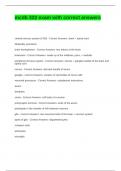NEUROGENETICS:
Course Description
- Advances in molecular biology and molecular genetics have allowed researchers to postulate
specific theories underpinning the genetic control of behavioral and neurological disease/
disorder mechanisms.
- This subunit will familiarize participants with this relatively new field by speaking to unsolved
problems in neuroscience, developmental and degenerative concepts in neurobiology, and
epigenetic contributors towards phenotypic manifestations.
Completion of this Course Will Lead to:
- An understanding of central methodologies and theories defining neurogenetics and the
appropriate terminologies for the field.
- An understanding of how to approach issues regarding genes and their influence on
neurological disease and behavior in a critical yet educated way.
- A general understanding of how neurogenetics research is carried out at classical, molecular.
and behavioural levels; as well as how these levels interlink.
- An improved ability to communicate the materials through academic discussion and written
assessments.
OVERVIEW:
L1: Introduction to Neurogenetics
L2: Neurological Disorders
INTRODUCTION TO NEUROGENETICS:
What is Neurogenetics?
• Neurogenetics refers to the study of the role of genetics in the development and function of
the nervous system. It is one of the key fields in modern neurobiology which attempts to
unravel the genetic basis of brain structure, brain development, and behaviour.
How?
1
, • Phenotypes + genetic make-up of the individual needs to be factored in.
• Therefore, neurogenetics is an integrated study.
• But the nervous system of individuals might not be identical (even for the same
species).
A Brief History of Neurogenetics:
• 1976 – Mullen et al discovery of locomotor mutants of mice.
• Lead on to behavioural mutants of Drosophila melanogaster. (By Benzer et al 1967 and was
influenced by Mullen)
• Neurological mutants’ model was made of Caenorhabditis elegans. Were able to see
behaviour. (Brenner et al. 1974) Were awarded a Nobel Prize for this model.
• 1970-80:
• Isolation of many neurological and behavioural mutants in Drosophila, C. elegans
and mouse models.
• 1980-present:
• Molecular genetic analysis of many neural genes: discovery of homologous neural
genes, conserved neural pathways. This progression is due to the increase in
technology.
• Whole genome sequences are available for many model organisms, which allow genomic
screens for developmental or behavioural mutants.
• The field of neurogenetics emerged from advances made in molecular biology, genetics, and
a desire to understand the link between genes, behaviour, the brain, and neurological
disorders and diseases. The field started to expand in the 1960s through the research of
Seymour Benzer, considered by some to be the father of neurogenetics.
• His (Prof Benzer) pioneering work with Drosophila helped to elucidate the link between
circadian rhythms and genes, which led to further investigations into other behaviour traits.
He also started conducting research in neurodegeneration in fruit flies in an attempt to
discover ways to suppress neurological diseases in humans. Many of the techniques he used
and conclusions he drew would drive the field forward.
• Early analysis relied on statistical interpretation through processes such as LOD (logarithm
of odds) scores of pedigrees and other observational methods such as affected sib-pairs,
which looks at phenotype and IBD (identity by descent) configuration:
• Phenotypes were given a score and then the genetics over past generations was
studied and these traits were seen how they were inherited.
• Many of the disorders studied early on including Alzheimer's, Huntington’s, and
amyotrophic lateral sclerosis (ALS) are still at the centre of much research to this
day.
2
, • By the late 1980s new advances in genetics such as recombinant DNA technology
and reverse genetics allowed for the broader use of DNA polymorphisms to test for
linkage between DNA and gene defects. This process is referred to sometimes as
linkage analysis.
• By the 1990s ever advancing technology had made genetic analysis more feasible
and available. This decade saw a marked increase in identifying the specific role
genes played in relation to neurological disorders. Advancements were made in but
not limited to: Fragile X syndrome, Alzheimer's, Parkinson's, epilepsy, and ALS.
Neurogenetics:
• Neurogenetics studies the role of genetics in the development and function of the nervous
system:
• It considers neural characteristics as phenotypes (i.e., manifestations, which can be
measurable or not, of the genetic make-up of an individual), and is mainly based on
the observation that the nervous systems of individuals, even of those belonging to
the same species, may not be identical.
• As the name implies, it draws aspects from both the studies of neuroscience and
genetics, focusing in particular how the genetic code an organism carries affects its
expressed traits.
• Mutations in this genetic sequence can have a wide range of effects on the quality of
life of the individual.
• Neurological diseases, behaviour, and personality are all studied in the context of
neurogenetics:
• The field of neurogenetics emerged in the mid to late 1900s with advances
closely following advancements made in available technology. Currently,
neurogenetics is the centre of much research utilizing cutting edge
techniques.
Definitions and Terminology:
• Neurogenetics:
• Neurogenetics deals with the relations between the genome and the nervous
system.
• Can be applied in 3 different ways:
1. Instrumental (applied):
• Use of neural mutants or genetic techniques as tools for
analysing structural or functional aspects of the nervous
system.
3
Course Description
- Advances in molecular biology and molecular genetics have allowed researchers to postulate
specific theories underpinning the genetic control of behavioral and neurological disease/
disorder mechanisms.
- This subunit will familiarize participants with this relatively new field by speaking to unsolved
problems in neuroscience, developmental and degenerative concepts in neurobiology, and
epigenetic contributors towards phenotypic manifestations.
Completion of this Course Will Lead to:
- An understanding of central methodologies and theories defining neurogenetics and the
appropriate terminologies for the field.
- An understanding of how to approach issues regarding genes and their influence on
neurological disease and behavior in a critical yet educated way.
- A general understanding of how neurogenetics research is carried out at classical, molecular.
and behavioural levels; as well as how these levels interlink.
- An improved ability to communicate the materials through academic discussion and written
assessments.
OVERVIEW:
L1: Introduction to Neurogenetics
L2: Neurological Disorders
INTRODUCTION TO NEUROGENETICS:
What is Neurogenetics?
• Neurogenetics refers to the study of the role of genetics in the development and function of
the nervous system. It is one of the key fields in modern neurobiology which attempts to
unravel the genetic basis of brain structure, brain development, and behaviour.
How?
1
, • Phenotypes + genetic make-up of the individual needs to be factored in.
• Therefore, neurogenetics is an integrated study.
• But the nervous system of individuals might not be identical (even for the same
species).
A Brief History of Neurogenetics:
• 1976 – Mullen et al discovery of locomotor mutants of mice.
• Lead on to behavioural mutants of Drosophila melanogaster. (By Benzer et al 1967 and was
influenced by Mullen)
• Neurological mutants’ model was made of Caenorhabditis elegans. Were able to see
behaviour. (Brenner et al. 1974) Were awarded a Nobel Prize for this model.
• 1970-80:
• Isolation of many neurological and behavioural mutants in Drosophila, C. elegans
and mouse models.
• 1980-present:
• Molecular genetic analysis of many neural genes: discovery of homologous neural
genes, conserved neural pathways. This progression is due to the increase in
technology.
• Whole genome sequences are available for many model organisms, which allow genomic
screens for developmental or behavioural mutants.
• The field of neurogenetics emerged from advances made in molecular biology, genetics, and
a desire to understand the link between genes, behaviour, the brain, and neurological
disorders and diseases. The field started to expand in the 1960s through the research of
Seymour Benzer, considered by some to be the father of neurogenetics.
• His (Prof Benzer) pioneering work with Drosophila helped to elucidate the link between
circadian rhythms and genes, which led to further investigations into other behaviour traits.
He also started conducting research in neurodegeneration in fruit flies in an attempt to
discover ways to suppress neurological diseases in humans. Many of the techniques he used
and conclusions he drew would drive the field forward.
• Early analysis relied on statistical interpretation through processes such as LOD (logarithm
of odds) scores of pedigrees and other observational methods such as affected sib-pairs,
which looks at phenotype and IBD (identity by descent) configuration:
• Phenotypes were given a score and then the genetics over past generations was
studied and these traits were seen how they were inherited.
• Many of the disorders studied early on including Alzheimer's, Huntington’s, and
amyotrophic lateral sclerosis (ALS) are still at the centre of much research to this
day.
2
, • By the late 1980s new advances in genetics such as recombinant DNA technology
and reverse genetics allowed for the broader use of DNA polymorphisms to test for
linkage between DNA and gene defects. This process is referred to sometimes as
linkage analysis.
• By the 1990s ever advancing technology had made genetic analysis more feasible
and available. This decade saw a marked increase in identifying the specific role
genes played in relation to neurological disorders. Advancements were made in but
not limited to: Fragile X syndrome, Alzheimer's, Parkinson's, epilepsy, and ALS.
Neurogenetics:
• Neurogenetics studies the role of genetics in the development and function of the nervous
system:
• It considers neural characteristics as phenotypes (i.e., manifestations, which can be
measurable or not, of the genetic make-up of an individual), and is mainly based on
the observation that the nervous systems of individuals, even of those belonging to
the same species, may not be identical.
• As the name implies, it draws aspects from both the studies of neuroscience and
genetics, focusing in particular how the genetic code an organism carries affects its
expressed traits.
• Mutations in this genetic sequence can have a wide range of effects on the quality of
life of the individual.
• Neurological diseases, behaviour, and personality are all studied in the context of
neurogenetics:
• The field of neurogenetics emerged in the mid to late 1900s with advances
closely following advancements made in available technology. Currently,
neurogenetics is the centre of much research utilizing cutting edge
techniques.
Definitions and Terminology:
• Neurogenetics:
• Neurogenetics deals with the relations between the genome and the nervous
system.
• Can be applied in 3 different ways:
1. Instrumental (applied):
• Use of neural mutants or genetic techniques as tools for
analysing structural or functional aspects of the nervous
system.
3










